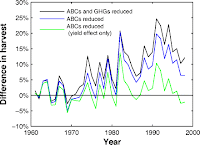Aerosols and green house gases responsible for reduction in rice harvest in India
An article by Auffhammer M, Ramanathan V. and Jeffery V in December 26th, 2006 issue of Proceedings of the National Academy of Sciences (PNAS), USA suggests that atmospheric brown cloud (ABC) and green house gases (GHG) are responsible for reduction in rice harvest in India. Atmospheric brown cloud is a term coined by Ramanathan to describe aerosol layer with absorbing nature of particles. Many scientist argue that aerosols are counteracting the warming trend due to green house gases and can be used to mitigate warming trend by putting them in stratosphere. However in case of rice harvest in India both aerosols and GHGs act complementary to each other with net effect of reduction in rice production.

Approach taken in this article is different in the sense that it is not about biogeophysical aspect. Rather it is a fusion of economical and general circulation models. Authors have used statistical approach to know how changes in rainfall or extreme temperatures affect area
to be harvested for rice. That is followed by simulations using general circulation model (GCM) to know how rainfall and temperatures going to be changed by ABC and GHG. Using previously derived statistical parameters and GCM results conclusion is drawn that both GHG and ABC negatively impacts the rice production in India.
Article is free to download under open source and can be reached at following link
Auffhammer, M., V. Ramanathan and Vincent J. R. (2006), Integrated model shows that atmospheric brown clouds and greenhouse gases have reduced rice harvests in India, PNAS, 103(52), 19668-19672, doi: 10.1073/pnas.0609584104.
In the same issue of PNAS, a commentary on this article by Cramer is appeared, which can be reached at following link.
Cramer, W. (2006), Air pollutioin and climate change both reduce Indian rice harvests, PNAS, 103(52), 19609-19610, doi: 10.1073/pnas.0610075103.
Image source: Proceedings of the National Academy of Sciences, USA

Approach taken in this article is different in the sense that it is not about biogeophysical aspect. Rather it is a fusion of economical and general circulation models. Authors have used statistical approach to know how changes in rainfall or extreme temperatures affect area
to be harvested for rice. That is followed by simulations using general circulation model (GCM) to know how rainfall and temperatures going to be changed by ABC and GHG. Using previously derived statistical parameters and GCM results conclusion is drawn that both GHG and ABC negatively impacts the rice production in India.
Article is free to download under open source and can be reached at following link
Auffhammer, M., V. Ramanathan and Vincent J. R. (2006), Integrated model shows that atmospheric brown clouds and greenhouse gases have reduced rice harvests in India, PNAS, 103(52), 19668-19672, doi: 10.1073/pnas.0609584104.
In the same issue of PNAS, a commentary on this article by Cramer is appeared, which can be reached at following link.
Cramer, W. (2006), Air pollutioin and climate change both reduce Indian rice harvests, PNAS, 103(52), 19609-19610, doi: 10.1073/pnas.0610075103.
Image source: Proceedings of the National Academy of Sciences, USA
Comments